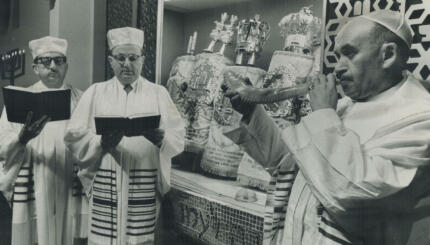Yom Kippur, the Day of Atonement, occurs on the 10th day of Tishrei, 10 days after Rosh Hashanah. Jewish tradition believes that on this day God places a seal upon the Divine decrees affecting each person for the coming year. In other words, decisions of life and death, peace and prosperity have all been decided and are now sealed. The Book of Life is closing on this day.
The sequence of events in the cycle of the Jewish year starts with Rosh Hashanah and continues through the next 10 days to culminate with Yom Kippur. Divine decisions are made on Rosh Hashanah, when all of humanity stands in judgment. These decrees are sealed on Yom Kippur and the intervening 8-day period, the Ten Days of Repentance, are the window of opportunity for the human dynamic to influence the Divine decrees. On Yom Kippur we make our final plea to God.
Yom Kippur is mentioned in the Torah and described as a day upon which we are to “afflict our souls.” This phrase has been interpreted by the rabbis to include prohibitions against eating, drinking, bathing, wearing leather shoes and sexual cohabitation. It is one of the major fasts in Judaism, meaning it begins at sundown and continues to the following sundown. The Torah specifically connects the concept of atonement with this day and that connection has remained central.
The idea of atonement includes accepting responsibility for our actions through prayers of confession. These prayers mention both individual and communal sins and make up a large portion of the prayer services on Yom Kippur. The evening begins with the prayer of Kol Nidre, which absolves the individual of unfulfilled personal vows between the individual and God for the coming year. Its haunting melody marks the start of the fast and sets the tone for the next 24 hours.
With your help, My Jewish Learning can provide endless opportunities for learning, connection and discovery.
Although Yom Kippur addresses both individual and communal sins, it is not a vehicle through which one corrects an injustice between individuals. There are two distinct relationships in Judaism: person to person and person to God. To atone for deeds committed against another person, Jewish tradition teaches, you must confront that person directly and apologize. Yom Kippur will address the impact that deed had on your relationship with God, but without the personal apology, the deed remains uncorrected. This element of the day often leads to difficult self-assessments and personal accountability for the choices made in the previous year.
Once the attempt has been made to confront and repent for misdeeds, the individual presents his or her “case” before God. The act of atonement makes the claim that as human beings we are able to change and improve ourselves. Thus we ask for one more year in which to continue this journey of change and improvement. We do not make the case to God that we are deserving of another year or deserving of blessings, rather that although we are undeserving (as our confessional prayers have pointed out), we contain within us the potential for righteousness and need time to actualize this potential.
Throughout the period of Rosh Hashanah and Yom Kippur, the shofar is blown regularly. The shofar and its sounds are complex symbolic images that call all Jews together and remind us of the power of these days. There are many beautiful images that the Rabbis of the Talmud attach to the shofar and its sounds. In its simplest form, the shofar connects us to our ancient history when we functioned in a tribal system but used the shofar to maintain communication and unity. (On Yom Kippur, the shofar is blown only once, one long blast at the very end of the holiday.)
Seen as a continuous thread, Rosh Hashanah and Yom Kippur reflect the annual introspection of the individual Jew and the Jewish community. On Rosh Hashanah God makes decisions and issues decrees regarding each individual. There are then 10 days upon which we can influence that decision, climaxing with Yom Kippur, the day upon which the seals are affixed. Referred to as the “Sabbath of Sabbaths,” Yom Kippur holds a crucial place in the Jewish calendar.
Rosh Hashanah
Pronounced: roshe hah-SHAH-nah, also roshe ha-shah-NAH, Origin: Hebrew, the Jewish new year.
shofar
Pronounced: sho-FAR or SHO-far, Origin: Hebrew, a ram’s horn that is sounded during the month of Elul, on Rosh Hashanah, and on Yom Kippur. It is mentioned numerous times in the Bible, in reference to its ceremonial use in the Temple and to its function as a signal-horn of war.
Torah
Pronunced: TORE-uh, Origin: Hebrew, the Five Books of Moses.
Yom Kippur
Pronounced: yohm KIPP-er, also yohm kee-PORE, Origin: Hebrew, The Day of Atonement, the holiest day on the Jewish calendar and, with Rosh Hashanah, one of the High Holidays.



